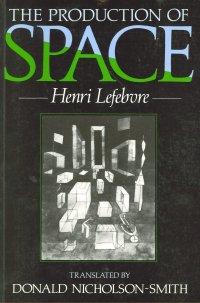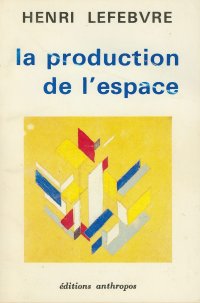

The Production of Space by Henri Lefebvre (1901-1991) is widely considered to be one of the most important books which facilitated the ‘spatial turn’ in social and cultural theory by introducing space, as an interpretative concept, into sociological, political, economic, historical and cultural analysis. This reorientation was the programmatic objective of this book which aimed to relate and define ‘all possible spaces, whether abstract or real, mental or social’ (p. 299), and thus account for a wide range of spaces, from those of the body to those of the planet.
This inclusive perspective characterised Lefebvre’s studies from the 1940s onwards. The Production of Space was based on a critical appropriation of Marxism and its philosophical sources as well as on an elaboration of several themes which were latent in the writings of Marx and Engels, like the role of the city and urban space in the emergence of capi-talism.1 In such books as The Right to the City (1968) and The Urban Revolution (1970) Lefebvre developed these ideas, defining urban space by its role in the processes of reproduction of capitalist relations of production.2 At the same time his focus on French post-war society was not restricted to political economy but included an investigation into modern everyday life with its distinctively spatial determinations: the new spaces of consumption, the retreat from politics to the domestic interior, the bureaucratic control of urban spaces, and the functionalist refraction of cities into spaces for work, housing, leisure and transportation.3 Engaged in research in rural sociology since the 1940s, Lefebvre was aware of the consequences of these phenomena for the countryside which was increasingly threatened by urban sprawl and ecological mishaps.4 These interests led him to a profound critique of functionalist urbanism in a series of empirical analyses of the post-war city development. They included the study of the new town of Mourenx in the Pyrenées Atlantiques and the investigation into domestic spaces in the research on the ‘pavillon’ (the French suburban detached house) carried out by the Institut de Sociologie Urbaine, co-founded by Lefebvre in 1962. Interestingly, the results of these empirical studies were referred to in his philosophical writings, including his critique of structuralism.5 Lefebvre’s investigations into urban space influenced and inspired French artistic and architectural avant-garde of the 1960s, most importantly the situationists and the Utopie group: while state socialism in Central and Eastern Europe failed to provide alternatives for capitalist everyday life, Lefebvre was highlighting the subversive potential of urban spaces as kernels of a new kind of society.6
The historical situatedness of Lefebvre’s writings was not only accepted by the author but also transformed into a research strategy. Already in the article ‘Qu’est-ce que le passé historique’ (1959), Lefebvre encouraged historians to take into account their own experience in their studies.7 In this essay, he wrote: ‘The past becomes present (or is renewed) as a function of the realisation of the possibilities objectively implied in this past.’8 Consequently, he argued for the ‘introduction of the category of the possible into historical methodology’.9 This category was inherent in the ‘progressive-regressive method’ formulated in the essay ‘Perspectives de la sociologie rurale’ (1953) where Lefebvre argued in favour of an investigation which proceeds from the contemporary situation in order to reveal its past determinants and to theorise the possibilities of future development.10
The introduction of the category of the ‘possible’ into research about space resulted in the concept of ‘social space’. In The Production of Space Lefebvre wrote (p. 73): ‘[...] itself the outcome of past actions, social space is what permits fresh actions to occur, while suggesting others and prohibiting yet others.’ Developing this concept, he theorised space both as a product of social practices and as their instrument, medium, and milieu (p. 411). This instrumentality of space was thus not limited to economic productivity, for it could also facilitate political engagement. Although formulated thirty years ago, this politicised concept of urban space has again become topical because it proposes an alternative to today’s dominant definition of urbanity in terms of consumption and spectacle.
2![]()
Lefebvre’s concept of space as socially produced and productive in social practices is ontologically heterogeneous. He distinguished two triads of ‘moments’ of space: spatial practices, representations of space and spaces of representation or, alternatively, the perceived, conceived and lived space. Spatial practices were theorised as practices of physical transformation of the environment; representations of space were understood as theories and effigies of space in science, architecture, urbanism, art, and mass-media; and spaces of representations - related to power, the body, ideas and ideologies - were described as appropriated and dominated by social groups. While spatial practices produce ‘perceived’ spaces, representations of space relate to ‘conceived’ spaces, and spaces of representation are approximated as ‘lived’ spaces. However, the relation between these two triads is never complete in The Production of Space, reflecting the uneasy relationship between two philosophical traditions on which Lefebvre’s theory of space was based: Marxism and phenomenology.
Read today, this hybrid conceptual framework appears to be one of Lefebvre’s most promising proposals, for it facilitates research about the contemporary complexity of processes in which urban spaces are produced: conditioned by economic and political determinations, transformed by technology, saturated with images, mediated in the news and yet constantly appropriated in the practices of everyday life. At the same time, the broadness of Lefebvre’s concept of space inevitably means that his theory is provisional and it cannot provide universal categories applicable in every context in the same way. Lefebvre underscored that the triad of spatial practices, representations of space and spaces of representation ‘loses all force if it is treated as an abstract ‘model’’ (p. 40). The three aspects of space cannot be grasped by one general formula, but must be studied by means of a detailed analysis which takes into account historically specific situations.
Lefebvre carried out several such analyses which included his account of the Paris Commune11 and his testimony about the ‘event’ of May 1968 in Paris.12 The latter was seen by Lefebvre as an ‘explosion’ of contradictions inherent in French post-war society, encapsulated in the functionalist space of Nanterre university campus, where he was a professor of sociology from 1965 to 1973. In both books Lefebvre examined dynamic ‘centralities’ understood as nodes of spatial practices, representations of space and spaces of representation, or perceived, conceived and lived space.
3![]()
These studies of historically specific centralities were developed in The Production of Space. The narration of a development from the mythical ‘natural’ space through the ‘absolute’ and ‘political space’ to the ‘abstract space’ of 20th century capitalism and the ‘differential’ space of future society is a part of Lefebvre’s book which has been often criticised, or discreetly passed over in silence by commentators sensitive to the shortcomings of grands récits. Although several of Lefebvre’s formulations justify this criticism, it seems more productive today to read his book less as a historicist exercise than as an analysis of historically specific relationships between the three ‘moments’ of space. In some ‘favorable’ circumstances the moments converge; in others they are divided by gaps, hiatuses and discrepancies, as it was the case - according to Lefebvre - with French post-war urbanism.
While criticised by many, Lefebvre’s open-ended and often ambiguous writings inspired a series of empirical research projects about both past and contemporary urban spaces. An overview of some of them allows for an insight into the variety of ways in which Lefebvre’s concepts and intuitions were developed. Interestingly, it was Manuel Castells who was among the first not only to reproach The Production of Space for lacking empirical data,13 but also to apply Lefebvre’s concepts in an analysis of historical urban transformations. In The City and the Grassroots (1983), a reference to Lefebvre’s theory allowed Castells to analyse the Paris Commune as an ‘urban revolution’ and to challenge its Marxist interpretation as a proletarian revolution.14 Another significant development of Lefebvre’s hypotheses was suggested by Bohdan Jałowiecki in his book Społeczne wytwarzanie przestrzeni (‘The Social Production of Space’, 1988). Jałowiecki proposed a historical analysis of the production of space ranging from pre-industrial societies to French post-war capitalism and socialist Poland, and analysed the instrumentalisation of space in late socialist politics and economy.15 In a different political and intellectual context, Edward Soja’s Thirdspace (1996) interpreted Lefebvre’s theory in relation to post-modern epistemologies and operationalised his work in an investigation of the political, economic and cultural geographies of Orange County in California and the Netherlands.16
Lefebvre’s theory is particularly fruitful for multidisciplinary analyses of urban spaces which combine a study of urban forms with historical, political, and sociological investigations. Recently, Christian Schmid’s interpretation of the theory of production of space17 provided the conceptual framework for the mapping of the processes of urbanisation in Switzerland.18 In France, after a period of distrust stemming from a recuperation of Lefebvre’s vocabulary by the state planning bureaucracy,19 several researchers returned to the theory of production of space. Laurent Devisme, for example, has mobilized Lefebvre’s concept of ‘centrality’ and developed a typology of centralities in order to grasp the characteristics of contemporary urban spaces (in Toulouse, Tours, Paris-la Défense, Hérouville).20 In my own research I have aimed to show how representations of space in Nowa Huta, a new town founded by the communist regime in Poland, became instruments and media of the production of space after 1989. It was Lefebvre’s theory which allowed grasping the ways in which representations of space influence the design, perception, use, and appropriation of urban spaces.21
4![]()
These examples suggest that the impact of The Production of Space reaches beyond a particular discipline - which is another argument why this book should be translated into German. Lefebvre’s theory provides contemporary urban and historical research with useful concepts, above all the concept of ‘social space’, conceived in terms of the triads of spatial practices, representations of space and spaces of representation, and of perceived, conceived and lived space. Being hybrid, this concept addresses the complexity and heterogeneity of the production of urban spaces; being open-ended, it allows adjusting the analyses to the specificity of each situation; being oriented towards the possible, it is sensitive to the tendencies of an emerging urban society.
1 Henri Lefebvre, La Pensée marxiste et la ville, Paris 1972.
2 Lefebvre, Le Droit à la ville, Paris 1968; Lefebvre, La Révolution urbaine, Paris 1970.
3 Lefebvre, Critique de la vie quotidienne, 3 volumes, Paris 1947/62/81.
4 Lefebvre, Du rural à l’urbain, Paris 1970.
5 Lefebvre, Au-delà du structuralisme, Paris 1971.
6 Lefebvre, De la science à la stratégie urbaine, in: Utopie 2/3 (1969), pp. 57-86.
7 Lefebvre, Qu’est-ce que le passé historique, in: Les Temps Modernes 161 (Juillet 1959), p. 159-169; in English: What is the Historical Past?, in: New Left Review 90 (1975), p. 27-34.
8 Ibid., p. 34.
9 Ibid.
10 Lefebvre, Perspectives de la sociologie rurale [1953], in: Lefebvre, Du rural à l’urbain (fn. 4), pp. 63-78.
11 Lefebvre, La Proclamation de la Commune, 26 mars 1871, Paris 1965.
12 Lefebvre, L’Irruption de Nanterre au sommet, Paris 1968.
13 Manuel Castells, La Question urbaine, Paris 1972; cf. Géraldine Pflieger, De la ville aux réseaux. Dialogue avec Manuel Castells, Lausanne 2006.
14 Castells, The City and the Grassroots, London 1983.
15 Bohdan Jaowiecki, Spoeczne wytwarzanie przestrzeni, Warsaw 1988.
16 Edward Soja, Thirdspace, Cambridge 1996.
17 Christian Schmid, Stadt, Raum, Gesellschaft. Henri Lefebvre und die Theorie der Produktion des Raumes, Stuttgart 2005.
18 Roger Diener et al., Die Schweiz - ein städtebauliches Portrait, Basel 2005.
19 Cf. Jean-Pierre Garnier, La vision urbaine de Henri Lefebvre, in: Espaces et societées 76 (1994), pp. 123-145.
20 Laurent Devisme, Actualité de la pensée d’Henri Lefebvre à propos de l’urbain. La question de la centralité, Tours 1998.
21 Łukasz Stanek, The instrumental use of representations of space in the practices of production of space in a postcommunist city, in: Patrick Healy/Gerhard Bruyns (eds.), De-/signing the Urban. Technogenesis and the Urban Image, Rotterdam 2006, pp. 284-301.
![]()
